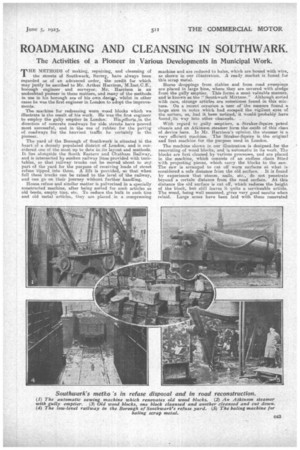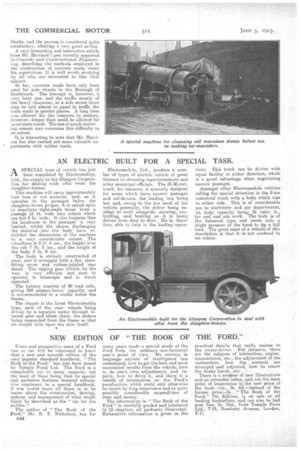ROADMAKING AND CLEANSING IN SOUTHWARK.
Page 27

Page 28

If you've noticed an error in this article please click here to report it so we can fix it.
The Activities of a Pioneer in Various Developments in Municipal Work.
THE METHODS of making, repairing, and cleansing of the streets. of Southwark, Surrey, have always been regarded as of an advanced order, the credit for which may justly be ascribed to Mr. Arthur Harrison, M.Inst.C.E.', borough engineer and surveyor. Mr. Harrison is an undoubted pioneer in these matters, and many of the methods in use in his borough are of his own .desigin, whilst in other cases he was the first engineer in London to adopt the improvements.
'The machine for redressing worn wood blocks which we illustrate i& the result of his work. He was the first engineer to employ the gully emptier in London. Hisiefforte,in the direction of concrete roadways for side streets have proved most successful, and in the use of rubber for the paving of roadways for the heaviest traffic he certainly is the pioneer.
The yard of the Borough of Southwark is situated in the heart of a densely populated district of London, and is Considered one of the most 1.11) to date in:its layout and methods. It lies alongside the South Eastern and Chatham Railway,. and is intersected by sunken railway lines .provided with turntables, so that railway trucks can bs moved about to any part of the yard for the purpose of receiving loads of street refuse tipped. into them. A lift is provided, so that when full these trucks can be raised to the level of the railway, and can go on their journey without further handling.
House refuse and similar matter is pulverized in a. specially constructed machine, after being sorted for such articles as old boots, empty tins, etc. To reduce the bulk in melt tine and old metal articles, they are placed. in a compressing
machine and are reduced to bales, which are bound -with wire, as shown in our illustration. A. ready market is . found for this scrap metal.
Horse droppings from stables and from road sweepings are placed in large bins, where they are covered with sludge from the gully emptier. This forms a most valuable manure, and is knowifas the Southwark Mixtune." Although sorted with care, strange articlea are sometimes found, in this mixture. On a recent oeeiteien a user exf -the manure found a large sum in notes which had, escaped the vigilant eyes of the sorters, as, had it been noticed,' it would:probably have found, its way into ether channels.
With regard to gully emptiers, a Straker-Squire petrol chassis and an Atkinsoe steamer form the outfit of this class of device here. In Mr. Harrison's opinion the steamer is a very efficient machine. " The Straker-Squire is the original and first machine for, the purpose used in London.
The machine shown in our illustration, is designed-for the renovating of wood blocks, and is automatic in its work. The blocks are first cleaned by various processes, and are placed in the machine, which consists of an endless chain fitted with projecting pieces, which carry the. blocks to the saw. The saw is arranged to cut off' worn surfaces at what is considered a safe distance frOm the old surface. It is found by experience that stonas, nails, etc. do not penetrate beyond a certain distance froth the road surface. At this distance the old surface is cut off, which reduces the height of the block, but still leaves it quite a serviceable article. The wood, being well seasoned, gives very good results when relaid. Large areas have been laid with these renovated
blocks, and the process is considered quite satisfactory, effecting a very great saving.
A very inteiesting and instructive article from Mr. Harrison's pen recently appeared ii Concreta and Constructional Enlinetring, describing the methods employed in the construction of concrete roads under his supervision. It is well worth studying by all who are interested in this vital subject.
So far, concrete roads have only been used for side streets in the Borough of Southwark. The borough is, however, a very busy one, and the traffic mostly of the heavy character, so a side street there may. be said almost to equal in traffic the main roads in quieter places. A long time was allowed for the concrete to ,mature, however--longer than could be allowed for plait main roads. The use of quick-maturing cement may overcome this difficulty to an extent.
it is interesting to note that Mr. Harrison has also carried out some valuable experiments with rubber roads.








































